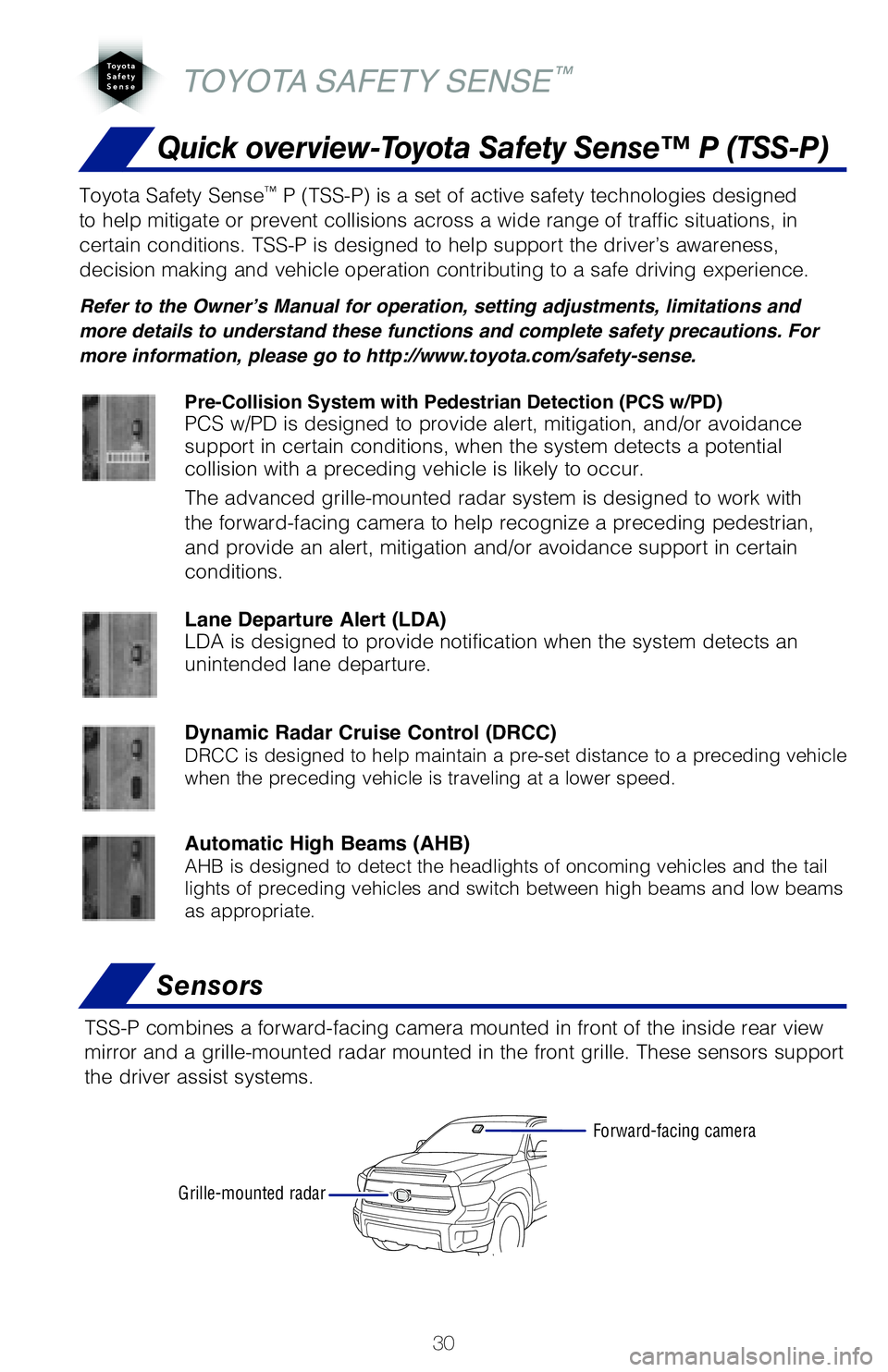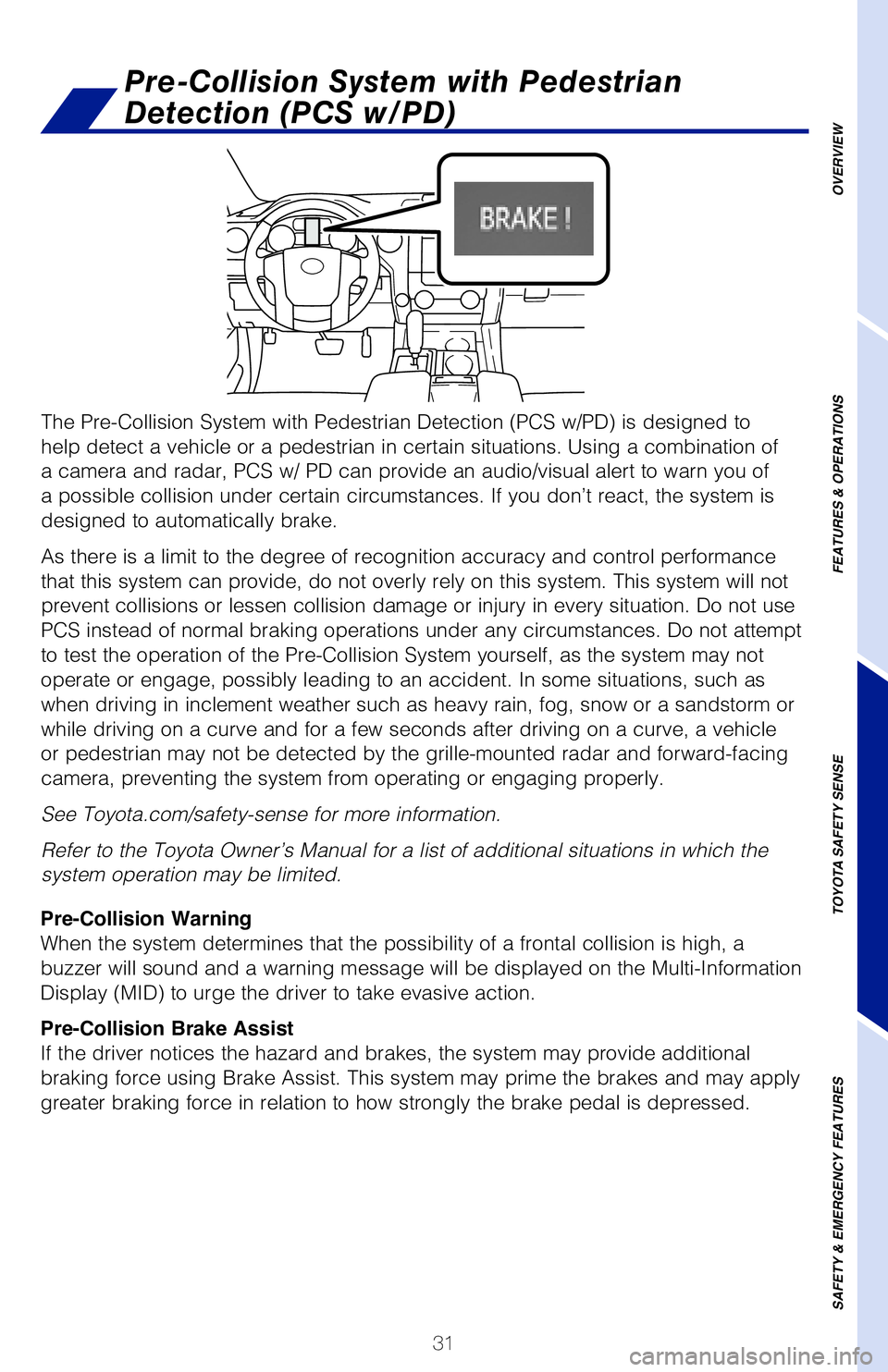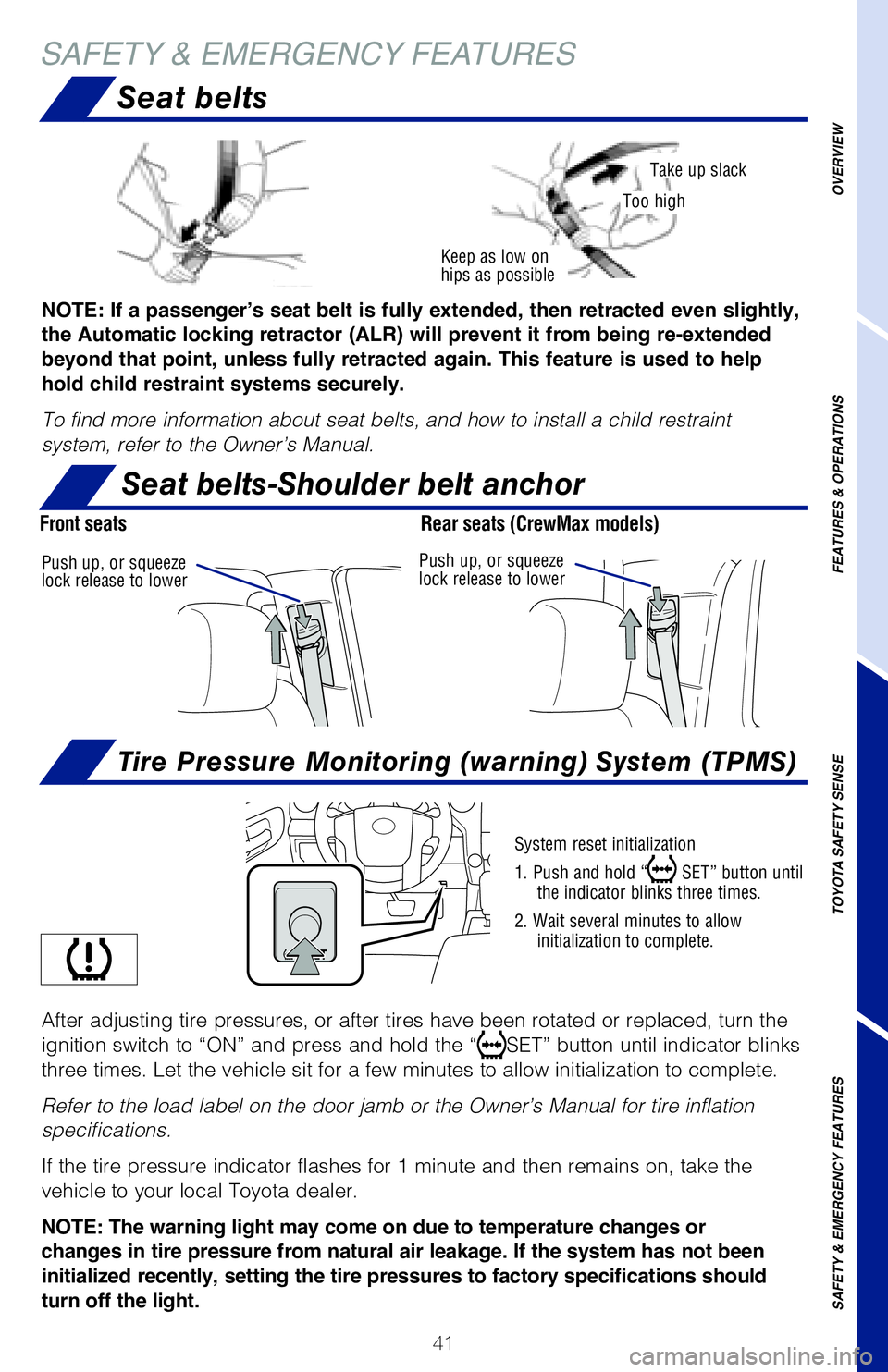headlights TOYOTA TUNDRA 2021 Owners Manual (in English)
[x] Cancel search | Manufacturer: TOYOTA, Model Year: 2021, Model line: TUNDRA, Model: TOYOTA TUNDRA 2021Pages: 52, PDF Size: 3.8 MB
Page 14 of 52

12
Lights & turn signals
HEADLIGHTS
FOG LIGHTS (IF EQUIPPED)
TURN SIGNALS
Daytime Running Light system (DRL) Automatically turns on under certain
conditions to make vehicle more visible to other drivers. Not for use at\
night.
Automatic light cut off system (AUTO) Automatically turns lights off after 30
second delay, or lock switch on the remote is pushed after all doors are\
locked. Automatic High Beams system (AHB) Automatically switches between high
and low beams as appropriate to enhance vision at night.
Refer to Toyota Safety Sense™ P (TSS-P) in this guide or the Owner’\
s Manual for
more details on the Automatic High Beams feature.
* Operating conditions must be met. Refer to the Owner’s Manual for d\
etails.
Front fog lights come on only when the headlights are on low beam.
* Move lever partway and release. The signals will flash three times.
Right turn
Lane change*
Lane change* Left turn
High beam
flasher (Pull)Parking lights
DRL OFF Auto
Headlights
Turn
OFF
ON
FEATURES & OPERATIONS
High beam (Push)
or
Automatic High Beams*
WITH INTERMITTENT WIPER
WITHOUT INTERMITTENT WIPER
* Intermittent windshield wiper frequency adjustment Rotate to increase/decrease wiper frequency.
Low beam
(Original position)
MY21_Tundra_QRG_V2_ML_0709.indd 127/13/20 10:54 AM
Page 32 of 52

30
The Pre-Collision System with Pedestrian Detection (PCS w/PD) is desig\
ned to
help detect a vehicle or a pedestrian in certain situations. Using a com\
bination of
a camera and radar, PCS w/ PD can provide an audio/visual alert to warn \
you of
a possible collision under certain circumstances. If you don’t react,\
the system is
designed to automatically brake.
As there is a limit to the degree of recognition accuracy and control pe\
rformance
that this system can provide, do not overly rely on this system. This sy\
stem will not
prevent collisions or lessen collision damage or injury in every situati\
on. Do not use
PCS instead of normal braking operations under any circumstances. Do not\
attempt
to test the operation of the Pre-Collision System yourself, as the syste\
m may not
operate or engage, possibly leading to an accident. In some situations, \
such as
when driving in inclement weather such as heavy rain, fog, snow or a san\
dstorm or
while driving on a curve and for a few seconds after driving on a curve,\
a vehicle
or pedestrian may not be detected by the grille-mounted radar and forwar\
d-facing
camera, preventing the system from operating or engaging properly.
See Toyota.com/safety-sense for more information.
Refer to the Toyota Owner’s Manual for a list of additional situation\
s in which the
system operation may be limited.
Quick overview-Toyota Safety Sense™ P (TSS-P)
Sensors
TSS-P combines a forward-facing camera mounted in front of the inside re\
ar view
mirror and a grille-mounted radar mounted in the front grille. These sen\
sors support
the driver assist systems.
TOYOTA SAFETY SENSE™
Toyota Safety Sense™ P (TSS-P) is a set of active safety technologies designed
to help mitigate or prevent collisions across a wide range of traffic si\
tuations, in
certain conditions. TSS-P is designed to help support the driver’s aw\
areness,
decision making and vehicle operation contributing to a safe driving exp\
erience.
Refer to the Owner’s Manual for operation, setting adjustments, limitations and
more details to understand these functions and complete safety precautions. For
more information, please go to http://www.toyota.com/safety-sense.
Automatic High Beams (AHB)AHB is designed to detect the headlights of oncoming vehicles and the ta\
il
lights of preceding vehicles and switch between high beams and low beams\
as appropriate. Pre-Collision System with Pedestrian Detection (PCS w/PD)
PCS w/PD is designed to provide alert, mitigation, and/or avoidance
support in certain conditions, when the system detects a potential
collision with a preceding vehicle is likely to occur.
The advanced grille-mounted radar system is designed to work with
the forward-facing camera to help recognize a preceding pedestrian,
and provide an alert, mitigation and/or avoidance support in certain
conditions.
Dynamic Radar Cruise Control (DRCC)
DRCC is designed to help maintain a pre-set distance to a preceding vehi\
cle
when the preceding vehicle is traveling at a lower speed.
Lane Departure Alert (LDA)
LDA is designed to provide notification when the system detects an
unintended lane departure.
Pre-Collision Warning
When the system determines that the possibility of a frontal collision i\
s high, a
buzzer will sound and a warning message will be displayed on the Multi-I\
nformation
Display (MID) to urge the driver to take evasive action.
Pre-Collision Brake Assist
If the driver notices the hazard and brakes, the system may provide addi\
tional
braking force using Brake Assist. This system may prime the brakes and m\
ay apply
greater braking force in relation to how strongly the brake pedal is dep\
ressed.
Forward-facing camera
Grille-mounted radar
MY21_Tundra_QRG_V2_ML_0709.indd 307/13/20 10:54 AM
Page 33 of 52

31
The Pre-Collision System with Pedestrian Detection (PCS w/PD) is desig\
ned to
help detect a vehicle or a pedestrian in certain situations. Using a com\
bination of
a camera and radar, PCS w/ PD can provide an audio/visual alert to warn \
you of
a possible collision under certain circumstances. If you don’t react,\
the system is
designed to automatically brake.
As there is a limit to the degree of recognition accuracy and control pe\
rformance
that this system can provide, do not overly rely on this system. This sy\
stem will not
prevent collisions or lessen collision damage or injury in every situati\
on. Do not use
PCS instead of normal braking operations under any circumstances. Do not\
attempt
to test the operation of the Pre-Collision System yourself, as the syste\
m may not
operate or engage, possibly leading to an accident. In some situations, \
such as
when driving in inclement weather such as heavy rain, fog, snow or a san\
dstorm or
while driving on a curve and for a few seconds after driving on a curve,\
a vehicle
or pedestrian may not be detected by the grille-mounted radar and forwar\
d-facing
camera, preventing the system from operating or engaging properly.
See Toyota.com/safety-sense for more information.
Refer to the Toyota Owner’s Manual for a list of additional situation\
s in which the
system operation may be limited.
Pre-Collision System with Pedestrian
Detection (PCS w/PD)
Quick overview-Toyota Safety Sense™ P (TSS-P)
Sensors
TSS-P combines a forward-facing camera mounted in front of the inside re\
ar view
mirror and a grille-mounted radar mounted in the front grille. These sen\
sors support
the driver assist systems.
Toyota Safety Sense
™ P (TSS-P) is a set of active safety technologies designed
to help mitigate or prevent collisions across a wide range of traffic si\
tuations, in
certain conditions. TSS-P is designed to help support the driver’s aw\
areness,
decision making and vehicle operation contributing to a safe driving exp\
erience.
Refer to the Owner’s Manual for operation, setting adjustments, limitations and
more details to understand these functions and complete safety precautions. For
more information, please go to http://www.toyota.com/safety-sense.
Automatic High Beams (AHB)AHB is designed to detect the headlights of oncoming vehicles and the ta\
il
lights of preceding vehicles and switch between high beams and low beams\
as appropriate. Pre-Collision System with Pedestrian Detection (PCS w/PD)
PCS w/PD is designed to provide alert, mitigation, and/or avoidance
support in certain conditions, when the system detects a potential
collision with a preceding vehicle is likely to occur.
The advanced grille-mounted radar system is designed to work with
the forward-facing camera to help recognize a preceding pedestrian,
and provide an alert, mitigation and/or avoidance support in certain
conditions.
Dynamic Radar Cruise Control (DRCC)
DRCC is designed to help maintain a pre-set distance to a preceding vehi\
cle
when the preceding vehicle is traveling at a lower speed.
Lane Departure Alert (LDA)
LDA is designed to provide notification when the system detects an
unintended lane departure.
OVERVIEW
FEATURES & OPERATIONS
TOYOTA SAFETY SENSE
SAFETY & EMERGENCY FEATURES
Pre-Collision Warning
When the system determines that the possibility of a frontal collision i\
s high, a
buzzer will sound and a warning message will be displayed on the Multi-I\
nformation
Display (MID) to urge the driver to take evasive action.
Pre-Collision Brake Assist
If the driver notices the hazard and brakes, the system may provide addi\
tional
braking force using Brake Assist. This system may prime the brakes and m\
ay apply
greater braking force in relation to how strongly the brake pedal is dep\
ressed.
MY21_Tundra_QRG_V2_ML_0709.indd 317/13/20 10:54 AM
Page 42 of 52

40
The Automatic High Beams (AHB) safety system is designed to help you s\
ee
more clearly at night. At speeds above 25 mph, AHB can detect the headli\
ghts of
oncoming vehicles and taillights of preceding vehicles, then automatical\
ly toggles
between high and low beams accordingly.
See Toyota.com/safety-sense for more information.
Refer to the Toyota Owner’s Manual for a list of additional situation\
s in which the
system operation may be limited.
Automatic High Beams (AHB)
(1) Push the lever away from you with the headlight switch is in the “\
” or
“AUTO” position.
(2) Press the “
” switch.
The AHB indicator will come on when the headlights are turned on automat\
ically
to indicate that the system is active.
Note: Pull the lever back toward you or press the AHB switch to turn the AHB
system off.
The AHB indicator will turn off and “
” or “” will turn on. To activate the
system again, push the lever its original position or press the “
” switch.
When all of the following conditions are met, the high beams will be aut\
omatically
turned on (after approximately 1 second): • Vehicle speed is above approximately 21 mph (34 km/h).
• The area ahead of the vehicle is dark.
• There are no oncoming or preceding vehicles with headlights or tail\
lights turned on.
• There are few street lights on the road ahead.
If any of the following conditions occur, the high beams will be automat\
ically turned off: • Vehicle speed drops below approximately 17 mph (27 km/h).
• The area ahead of the vehicle is not dark.
• Oncoming or preceding vehicles have headlights or tail lights turne\
d on.
• There are many streetlights on the road ahead.
ACTIVATING THE AHB SYSTEM
CONDITIONS WHERE AHB WILL TURN ON/OFF AUTOMATICALLY
(1) (2)
TOYOTA SAFETY SENSE™SAFETY & EMERGENCY FEATURES
After adjusting tire pressures, or after tires have been rotated or repl\
aced, turn the
ignition switch to “ON” and press and hold the “
SET” button until indicator blinks
three times. Let the vehicle sit for a few minutes to allow initializati\
on to complete.
Refer to the load label on the door jamb or the Owner’s Manual for ti\
re inflation
specifications.
If the tire pressure indicator flashes for 1 minute and then remains on,\
take the
vehicle to your local Toyota dealer.
NOTE: The warning light may come on due to temperature changes or
changes in tire pressure from natural air leakage. If the system has not\
been
initialized recently, setting the tire pressures to factory specificatio\
ns should
turn off the light.
Push up, or squeeze
lock release to lower
NOTE: If a passenger’s seat belt is fully extended, then retracted even slightly,
the Automatic locking retractor (ALR) will prevent it from being re-extended
beyond that point, unless fully retracted again. This feature is used to help
hold child restraint systems securely.
To find more information about seat belts, and how to install a child re\
straint
system, refer to the Owner’s Manual.
Front seats
MY21_Tundra_QRG_V2_ML_0709.indd 407/13/20 10:54 AM
Page 43 of 52

41
The Automatic High Beams (AHB) safety system is designed to help you s\
ee
more clearly at night. At speeds above 25 mph, AHB can detect the headli\
ghts of
oncoming vehicles and taillights of preceding vehicles, then automatical\
ly toggles
between high and low beams accordingly.
See Toyota.com/safety-sense for more information.
Refer to the Toyota Owner’s Manual for a list of additional situation\
s in which the
system operation may be limited.
Automatic High Beams (AHB)
(1) Push the lever away from you with the headlight switch is in the “\
” or
“AUTO” position.
(2) Press the “
” switch.
The AHB indicator will come on when the headlights are turned on automat\
ically
to indicate that the system is active.
Note: Pull the lever back toward you or press the AHB switch to turn the AHB
system off.
The AHB indicator will turn off and “
” or “” will turn on. To activate the
system again, push the lever its original position or press the “
” switch.
When all of the following conditions are met, the high beams will be aut\
omatically
turned on (after approximately 1 second): • Vehicle speed is above approximately 21 mph (34 km/h).
• The area ahead of the vehicle is dark.
• There are no oncoming or preceding vehicles with headlights or tail\
lights turned on.
• There are few street lights on the road ahead.
If any of the following conditions occur, the high beams will be automat\
ically turned off: • Vehicle speed drops below approximately 17 mph (27 km/h).
• The area ahead of the vehicle is not dark.
• Oncoming or preceding vehicles have headlights or tail lights turne\
d on.
• There are many streetlights on the road ahead.
Seat belts
SAFETY & EMERGENCY FEATURES
baT
Keep as low on
hips as possible
Take up slack
Too high
System reset initialization
1. Push and hold “
SET” button until
the indicator blinks three times.
2. Wait several minutes to allow initialization to complete.
After adjusting tire pressures, or after tires have been rotated or repl\
aced, turn the
ignition switch to “ON” and press and hold the “
SET” button until indicator blinks
three times. Let the vehicle sit for a few minutes to allow initializati\
on to complete.
Refer to the load label on the door jamb or the Owner’s Manual for ti\
re inflation
specifications.
If the tire pressure indicator flashes for 1 minute and then remains on,\
take the
vehicle to your local Toyota dealer.
NOTE: The warning light may come on due to temperature changes or
changes in tire pressure from natural air leakage. If the system has not been
initialized recently, setting the tire pressures to factory specificatio\
ns should
turn off the light.
Push up, or squeeze
lock release to lower Push up, or squeeze
lock release to lower
NOTE: If a passenger’s seat belt is fully extended, then retracted even slightly,
the Automatic locking retractor (ALR) will prevent it from being re-extended
beyond that point, unless fully retracted again. This feature is used to help
hold child restraint systems securely.
To find more information about seat belts, and how to install a child re\
straint
system, refer to the Owner’s Manual.
Seat belts-Shoulder belt anchor
Tire Pressure Monitoring (warning) System (TPMS)
Front seats
Rear seats (CrewMax models)
OVERVIEW
FEATURES & OPERATIONS
TOYOTA SAFETY SENSE
SAFETY & EMERGENCY FEATURES
MY21_Tundra_QRG_V2_ML_0709.indd 417/13/20 10:54 AM